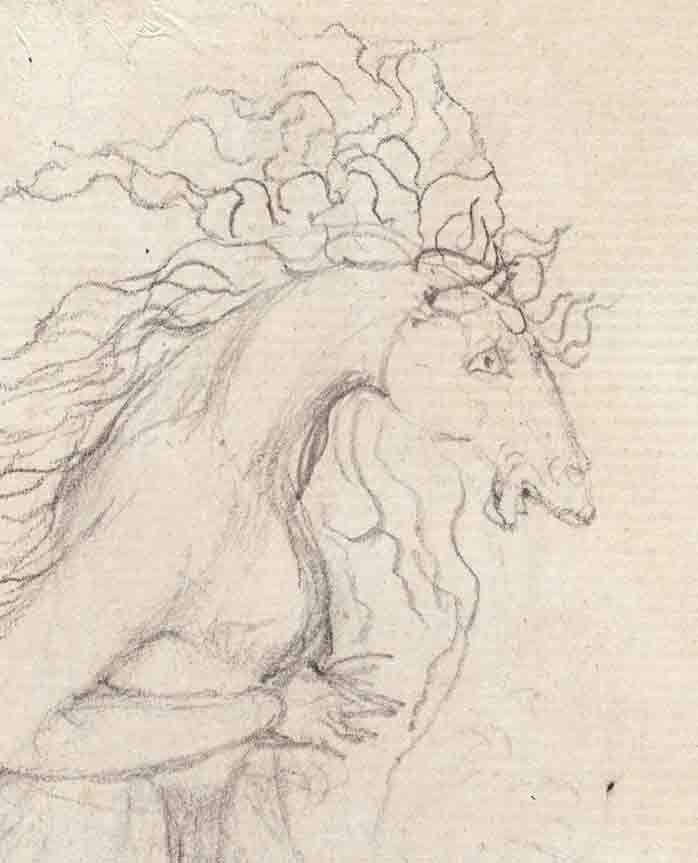The William Blake Archive is pleased to announce the publication of a digital edition of forty-three pencil drawings produced by Blake during his first decade as an independent artist, 1779-1790.
Drawing lies at the core of Blake’s life as an artist. Pencil was his preferred medium for sketching—more flexible, less expensive, and more easily corrected than pen and ink or chalk. Preliminary work with the pencil preceded more finished work, either as separate sketches for prints and paintings or as drawings underlying water colors. Blake’s nineteenth-century writings on the arts testify to his conviction that drawing was fundamental to all pictorial expression:
The distinction that is made in modern times between
a Painting and a Drawing proceeds from ignorance of
art. The merit of a Picture is the same as the merit of
a Drawing.
(A Descriptive Catalogue, Erdman page 549)
Let a Man who has made a Drawing go on & on & he
will produce a Picture or Painting but if he chooses
to leave off before he has spoild it he will Do a Better
Thing[.]
(Public Address, Erdman page 576)
Painting is Drawing on Canvas & Engraving is Drawing
on Copper & Nothing Else…& he who Draws best must
be the best Artist….
(Public Address, Erdman page 582)
Dear Sir, excuse my enthusiasm or rather madness, for I
am really drunk with intellectual vision whenever I take
a pencil or graver into my hand….
(letter to William Hayley, 1804, Erdman page 757)
Blake no doubt executed a great many more pencil drawings than those extant today. Sketches were not intended for exhibition or sale; most were probably discarded, while others may have been retained only because of more developed compositions on the other side of the leaves. Even the slightest and least aesthetically ambitious drawings offer insights into the origins and earliest realizations of Blake’s designs. These first thoughts on paper often tell us more about Blake’s habits of mind, when joined by eye and hand, than more finished works. Sketches are “the first fruits of [Blake’s] imagination,” as Geoffrey Keynes states in the introduction to his Pencil Drawings of William Blake (1927).
The pencil drawings now published show his early debt to academic standards of precise copying and to the neoclassical emphasis on outline. The first four works may have been drawn while Blake was a student in the Royal Academy schools. Other sketches are preliminaries for some of Blake’s most important designs. Among these are the Study for “Glad Day,” or “Albion Rose” (Object 6), Blake’s iconic vision of the human form divine in energetic pose, and three sketches (Objects 34-36) for illustrations to Tiriel, the only group of finished drawings Blake composed for one of his own poems. Several sketches are early efforts at picturing events in the Bible, Blake’s main inspiration for designs throughout his life. This biblical cluster includesThe Resurrection of the Dead (Object 10), Samuel Presenting Saul to the People (Object 15), and Job’s Wife and Other Sketches (Object 31). Other studies, such as Ugolino in Prison and its verso (Objects 21-22), reveal the beginnings of subjects also of lifelong interest for Blake. Only a few drawings for Blake’s illuminated books have survived, but studies such as Sketches for “The Book of Thel” and A Standing and a Recumbent Figure (Objects 37-39) offer fascinating glimpses into Blake’s methods of graphic production and revision.
As always, the William Blake Archive is a free site, imposing no access restrictions and charging no subscription fees. The site is made possible by the University of North Carolina at Chapel Hill with the University of Rochester, the continuing support of the Library of Congress, and the cooperation of the international array of libraries and museums that have generously given us permission to reproduce works from their collections in the Archive.
Morris Eaves, Robert N. Essick, and Joseph Viscomi, editors
Joseph Fletcher, managing editor, Michael Fox, assistant editor
The William Blake Archive

